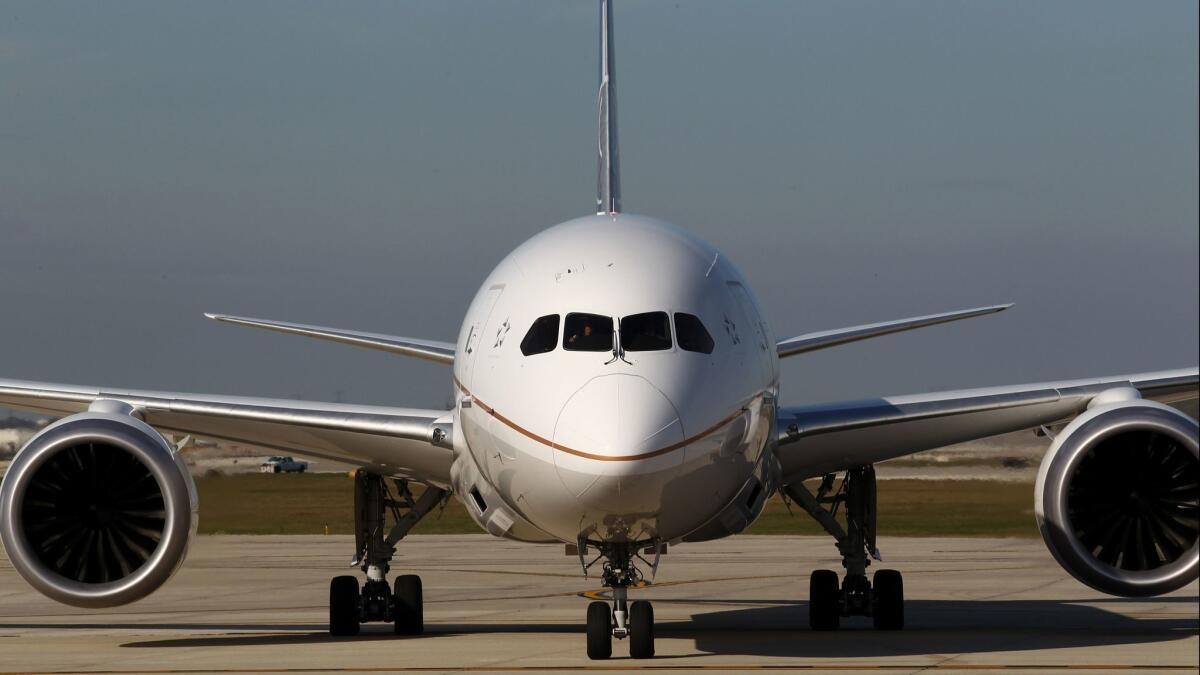Keeping passengers safe from aircraft predators

- Share via
As we as a nation grapple with sexual misconduct, we tend to think of this as an earthbound-issue. It’s not.
In December, CNN reported on the experiences of four women who said they were sexually assaulted or harassed on commercial airliners.
The problem, CNN reported, appears to be growing.
The incidents included “repeated groping and unwanted touching at the hands of a man,” the report said.
Because many incidents of sexual assault or harassment go unreported, the exact number of in-flight occurrences is unclear.
But, CNN said, “FBI investigations into midair assaults have increased by 66% from fiscal year 2014 to 2017. The bureau says it opened 63 investigations into sexual assault on aircraft [in 2017], compared with 57 in 2016, 40 in 2015 and 38 in 2014.”
One such incident occurred in 2016 on a flight from Dallas to Portland, Ore. A 13-year old girl, traveling as an unaccompanied minor, was sexually assaulted by 26-year-old Chad Cameron Camp who was seated next to her, authorities said. According to the criminal complaint in the case, a flight attendant happened to notice a single tear on the girl’s cheek. The attendant also noticed Camp’s hand near the girl’s crotch, the complaint said.
The girl was immediately reseated in another area of the airplane. Police and FBI agents met the plane and arrested Camp.
Camp subsequently pleaded guilty to assault with intent to commit abusive sexual contact of a minor and to indecent sexual proposal of a minor. As part of a plea agreement, he spent 11 months in jail and six months in home detention. For the next 15 years he’ll be a registered sex offender.
How do airline employees prevent such incidents? British Airways tried a radical solution. For many years, male passengers on its planes were not assigned seats next to an unaccompanied minor.
If by chance a man ended up sitting beside the child, flight attendants were required to move him to a different seat.
This policy led to a discrimination lawsuit filed by a male passenger who said he felt he had been treated like a pedophile. In 2010, the policy ended. Six years later, British Airways abolished its unaccompanied-minor program.
Compared with most gathering places, an airborne aircraft is one of the few settings in which the public has no direct access to police or security personnel. In a bar, office building or concert hall, security guards often handle problems until police can respond.
Assaults on buses and trains are dealt with as soon as the conductor stops to allow authorities onboard. On a cruise ship, onboard security officers can lock offenders in a brig until the next port of call.
But an airplane is different. If an assault occurs, it could be hours before the plane lands. Meanwhile, there’s no brig. There are no onboard security officers trained to subdue a suspect. (As for air marshals, of the 7,000 or so flights I’ve worked as a flight attendant in the last three decades, fewer than 20 flights took off with air marshals onboard.)
Flight attendants are trained in conflict resolution and situational awareness. We routinely separate combatants, calm frayed nerves and identify passengers with a variety of hard-to-read issues. Some of us have been trained to recognize possible human traffickers.
But there’s no blueprint on how to handle claims of in-flight sexual assault. It’s an issue we have yet to be thoroughly trained for.
Of the women in the CNN report who said they experienced sexual misconduct on an airliner, one made a striking comment about the crew’s handling of her ordeal.
“I felt like no one, no one that was supposed to be in charge could handle the situation,” she was quoted as saying. “I kept on feeling … like I’m the one who is doing something wrong, and I’m not being protected.”
At 30,000 feet, the best protection is for crew members to move an accuser as far from a suspect as possible. Ask her to write a detailed account of what transpired. Gather witness statements. Implore the captain to radio ahead so authorities can meet the aircraft.
To subdue criminally disruptive passengers, able-bodied flight attendants — myself included — have been forced to tackle and subdue suspects.
It’s in my best interest as a representative of the airline to know how to deal with sexual misconduct and to address it. It’s also in my best interest as a human being. After all, I have a girlfriend, a mother and a sister, all of whom fly commercial airlines, and my 14-year-old niece flies frequently as an unaccompanied minor.
Twitter: @latimestravel
More to Read
Sign up for The Wild
We’ll help you find the best places to hike, bike and run, as well as the perfect silent spots for meditation and yoga.
You may occasionally receive promotional content from the Los Angeles Times.






